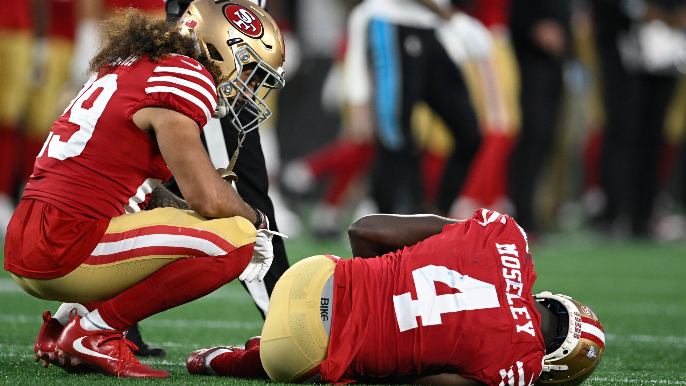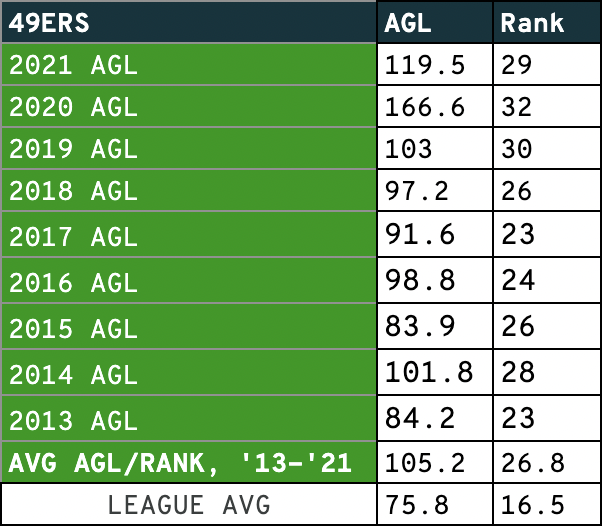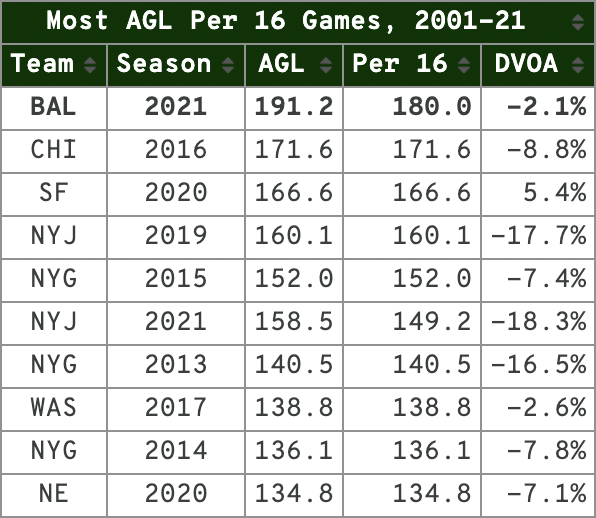
This isn’t a today problem; or a this week, this month, this year problem.
This is a decade-long issue.
Injuries have assaulted the San Francisco 49ers over the last 10 seasons like a plague. You’re sick of hearing about them. I’m sick of writing about them. The 49ers are sick of dealing with them.
But we cannot stop talking about injuries because the injuries refuse to stop.
Yes, it’s football. Injuries are inevitable.
However, there’s a chasmic difference between the typical wear and tear NFL teams and players deal with and what the 49ers deal with.
They are the most consistently injured team of the last decade.
This is through multiple regimes and performance staffs. This an issue that has spanned three presidents. San Francisco has had that many strength and conditioning coaches (Dustin Perry-current, Ray Wright, Mark Uyeyama) in that time.
Here is what the 49ers are currently dealing with on the injury front, after a game which saw Mike McGlinchey (calf) and Charvarius Ward (groin) both depart after the first half, along with a few other, seemingly minor injuries:
(Colton McKivitz is on injured reserve and presumed out roughly eight weeks. He may not return because teams can only have eight returns from injured reserve in a season. The 49ers have used two returns on Jimmie Ward and Curtis Robinson).
They entered this game as the league’s most injured team.
Per Man Games Lost, a statistical resource which tracks games lost to injury (and which cites the 49ers as one of their 21 NFL clients), the 49ers have been the most impacted by injuries when accounting for the quality of their injured players:
That is also supported by NFL on FOX’s injury analyst, who has created a composite of injury rankings.
Per his metric, the 49ers were the least healthy team in the league entering this week:
Now, injuries aren’t the sole reason the 49ers lost on Sunday.
- The Jeff Wilson Jr. fumble on the second drive put them in a two-touchdown hole.
- On a third-and-12, about to get the ball back late in the second half, they let Marcus Mariota scramble for 15 yards; that drive ended in a touchdown.
- There was a missed deep connection to Ray-Ray McCloud.
- Charlie Woerner had an unacceptable drop that would likely have led to a score.
- A deep completion to Brandon Aiyuk was wiped away for a holding call on Jake Brendel, who had a snap infraction on that same drive, which took eight minutes without resulting in a necessary touchdown.
This is a game the 49ers, as hobbled as they were, could have won.
The defense allowed 21 points. The offense mustered just 14 and allowed 7. Mistakes, unrelated to injuries, were a problem.
But the Falcons were able to grind the 49ers’ defense into a pulp with a steady dose of three-yard runs from their bowling ball backs in Tyler Allgier and Caleb Huntley. It was an exhaustion-inducing approach which was especially successful against an already hobbled team.
Losing Ward and McGlinchey at halftime was not a helpful development. Not having Nick Bosa, Arik Armstead or Javon Kinlaw probably affected the outcome.
The 49ers had three key players — in Talanoa Hufanga, Samson Ebukam and Drake Jackson — all head to the sidelines at one point on the Falcons’ opening touchdown drive. Injuries, while not exclusively to blame, played a substantial role.
And yes, Sunday was another game on turf. Turf is obviously an issue with injuries. I covered that earlier this week, here. The league should mandate grass surfaces.
But what can’t be explained is why it seems that the 49ers are so much more susceptible to turf and injuries on other surfaces.
There are 16 teams play at least half their games on turf. Are they better off because they’re used to that surface? Even if they are, why does San Francisco continue to suffer more than other teams with grass fields?
The questions are so much bigger than Sunday’s loss.
Per Football Outsiders’ Adjusted Games Lost metric, which has undergone changes over the years, but seeks to quantify how significant injuries are, the 49ers are the most injured team of the previous nine seasons (they don’t have available numbers for this season).
San Francisco’s best ranking by that metric since 2013? 23rd, or 10th-worst.
Here’s their most recent breakdown of the statistic:
“Adjusted games lost doesn’t just add up total injuries. It accounts for both absent players and those playing at less than 100%, and it gives more weight to injuries to expected starters and situational players than to expected back-ups. As such, AGL estimates the impact of injuries on teams and provides a comparable total that often succinctly explains why teams improved or declined from one year to the next.”
Here is how the 49ers have performed in adjusted games lost (AGL) and their rank in that timeframe:

What’s especially stunning about that 2020 season is that, while it was a COVID-19-riddled year, the 49ers were barely affected by COVID, losing just 5.0 games to COVID.
Since Football Outsiders started tracking injuries in 2001, that season ranks as the third-worst recorded. It’s still third-worst without COVID.

Let’s get through one last chart to really hammer the point home.
Below is every team’s average AGL since the 2013 season, when the 49ers’ downturn began. In the year prior, they ranked first. San Francisco has lost 30 games more than the league average each year.
San Francisco is the only team to rank in the bottom 10 every single year since 2013.
This is more than being snakebitten, or bad luck.
It is a bizarre, astonishingly persistent specter that hangs over this team like a haunted Karl the Fog.
The most confounding component is how inexplicable it is.
I have no idea how you solve this. Clearly the 49ers don’t, either, or something would change. They overhauled their training staff in 2019. That hasn’t solved their woes.
It is an organization which is pretty universally viewed as well run. If there was a clear answer, they would have found it.
The only logical proposal I can come up with is to invest more money into player health. But that’s a vague suggestion. Maybe hire more analysts to analyze how the team gets injured and how to prevent that? More trainers? More everything?
All that said — and while there are no figures readily available — this organization invests plenty into its training staff. Ben Peterson, the team’s head of player health & performance, has an office at the entrance of the team’s locker room. There’s a brand new recovery room in the locker room itself.
Players have individual nutrition labels on their lockers so performance staff can make sure they have food part of their dietary program readily available. They have specific smoothie and food orders saved so that they can be prepared instantly in the team cafeteria.
If you want this training staff fired, that’s your prerogative. It’s a reasonable enough instinct as the most logical area to blame.
But this has been an issue regardless of who runs the team’s training staff. There’s no evidence to suggest changing the training staff for the second time in four years would solve the issue.
The other problem with that criticism is that none of us see what goes on behind the scenes. You can say, “look at all the injuries, their training staff must be doing terribly,” but no one is seeing the job they’re actually doing.
We’re not witnesses to the process, just the unfortunate result.
Unless you’re a qualified physical therapist, doctor, former professional athlete, or some sort of licensed medical professional, though, you don’t really know what it takes to try and keep a professional sports franchise healthy.
The training staff, more than anyone, has a vested interest in preventing injuries. Their jobs are threatened by injuries. You can be sure they’re trying to figure this out.
They carry a heavy burden in caring for injured players. Even in a sport as brutal as football, there’s no getting used to the mental and physical exhaustion of the road back from season-ending and long-term injuries.
Everyone wants to figure this out, but the root cause remains elusive.
Whatever your hypothesis is, propose it.
Do the 49ers need to be more physical in practice? Less physical? Not practice at all? Put everyone in a cryo chamber until kickoff every week?
For the last five years, Kyle Shanahan and his staff have been trying to find these answers to running an offseason and training camp program to get players in shape without getting them injured before the season starts. They continue to think actively and thoughtfully about the best approach into the season.
And despite that, every year, this team is riddled with injuries.
That’s what’s so maddening. Different approaches have been tried. Different people have been employed. And yet, this annual problem remains in a way that is unique to the 49ers.
Forget logical explanations. We’re past that point.
Curses, hexes, some combination of necromancy and voodoo explain this team’s health woes more satisfactorily than any pseudo-scientific suggestion. Halloween’s around the corner anyway; at this point, the 49ers might as well experiment with dark magic. Traditional means haven’t been effective.
You’re not crazy for letting these injuries make you crazy. When something keeps happening without a rational explanation, remaining level-headed is irrational.

